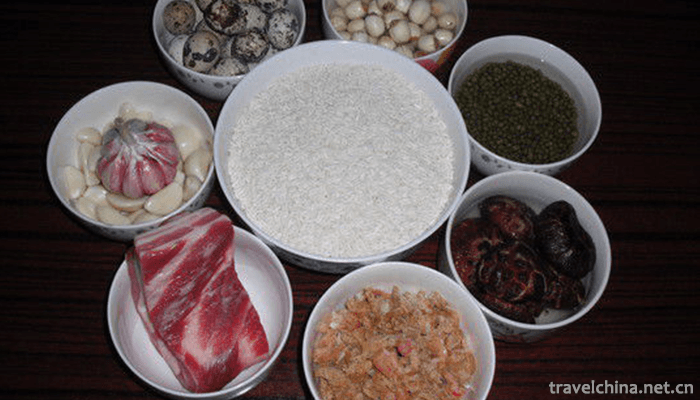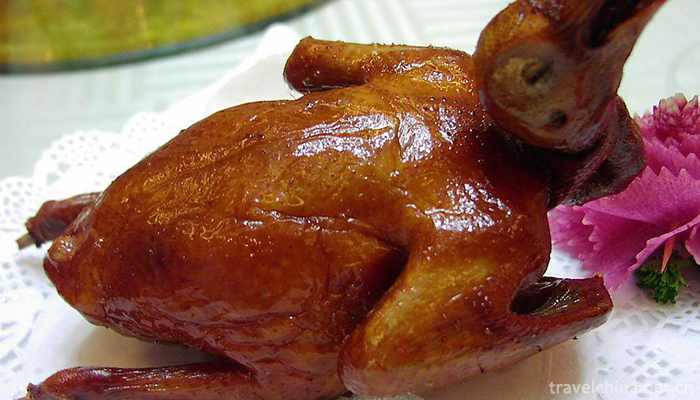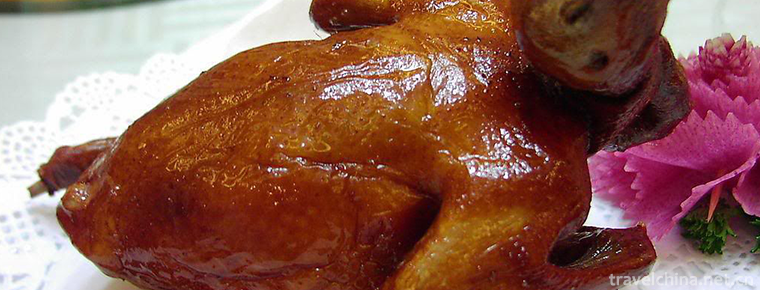Eight treasures quail
Eight treasures quail
Babao quail is a dish. Its main ingredient is pure quail, etc. Its ingredients are purple quail, lotus seed, etc. Its seasoning is peanut oil, salt, soy sauce and so on. It is made by deep-frying.
Recipe Brief
Delicious taste, delicious glutinous taste.
Lycium barbarum 10g, pork 50g, starch 15g, canned bamboo shoots 25g, salt 2.5g, cooking wine 15g, clove 8 grains, onion 10g, pepper 2g, cooked peanut oil 1500g (actual consumption 60g), ginger 10g, onion 15g, lobster slices 50g, hot sauce 50g*
Making process
1. After removing the quail's head, Debone it, wash it, drain the water, and taste it with salt, cooking wine, shallot and ginger powder, and marinate it.
2. Cut pork and canned bamboo shoots into dices. Lotus seeds, wolfberry, sage, clove and pepper are soaked with clear water and dehydrated.
3. Diced meat, bamboo shoots, lotus seeds, Lycium barbarum, Radix scutellariae, shallot powder and ginger powder are mixed with refined salt and cooking wine. A little cooked peanut oil is stirred and evenly filled. It is put into quail belly and steamed in a pot. Cloves, pepper, onion and ginger slices are steamed in a steaming pot, then cooled and dried. Take starch and fry it.
4. When the frying pan is heated, add cooked peanut oil to 50% heat, put lobster slices into the frying pan, fry them crisply and fish them out. When the oil is heated to 60% heat, fry quails into the frying pan, fry them until golden brown, fish them out and put them into small plates with lobster slices edged.
5. When eating, the hot sauce can be put into a small dish with a single heel.



-
1.Chengdu Panda Base
No. 1375 panda Road, Chenghua District, Chengdu city, Sichuan province
Time 2018-09-28 -
2.Old Summer PalaceYuanmingyuan
No. 28 Qinghua West Road, Haidian District, Beijing, China
Time 2018-10-03 -
4.Jiuhuangshan Ape King Cave Scenic Area
Jiuhuangshan Ape King Cave Scenic Area, located in Beichuan Qiang Autonomous County of Mianyang, Sichuan Province, is the largest karst cave in southwest China and a famous tourist cave in Western Chi
Time 2018-12-22 -
5.Pagoda of Xing Jiao Temple
Hingjiao Temple Pagoda is located in the original Hingjiao Temple of Shaoling, Chang'an District, Xi'an Province, Shaanxi Province. It is a famous figure in the history of Buddhist communication
Time 2018-12-24 -
6.Guyuan Northern Dynasty Sui and Tang Dynasties Cemetery
The tombs of the Northern Dynasty and Sui and Tang Dynasties in Guyuan are located in Xiaomazhuang, Yangfang, Shengou, Dabao, Wanglioba, five natural villages in the West and south suburbs of Yuanzhou
Time 2019-01-12 -
7.Hongfeng Lake Scenic Area
Hongfeng Lake Scenic Spot is located in the western suburb of Guiyang City, Guizhou Province, China. It is 28 kilometers away from Guiyang, the capital of Guizhou Province.
Time 2019-01-16 -
8.Fengyang flower drum
Fengyang flower drum is also known as "flower drum", "beating flower drum", "flower drum gong", "double drum" and so on. Fengyang flower drum originated in Linh
Time 2019-04-29 -
9.Han tune
The mast of Hanzhong Diaoqu, a local traditional drama in Hanzhong City, Shaanxi Province, is one of the national intangible cultural heritages.
Time 2019-05-02 -
10.Ancient dance Lao Gu dance
Ancient dance, the meaning of "breaking through the barrier" in Li language, is called "ancestor-telling" in ancient books. The ancestor worship originated from the primitive socie
Time 2019-05-11 -
11.Legend of Liu Yi
The legend of Liu Yi's biography is one of the oldest popular folklores in Chinese history. With Liang Zhu, Tianxian Pair and White Snake Legend, they are called the four legends of Chinese folklore.
Time 2019-05-14 -
12.Raise the Pavilion
Lifting the pavilion, also known as the pavilion, is a unique traditional folk dance that integrates historical stories, myths and legends, and integrates painting, opera, tie-up, paper sculpture, acr
Time 2019-06-18